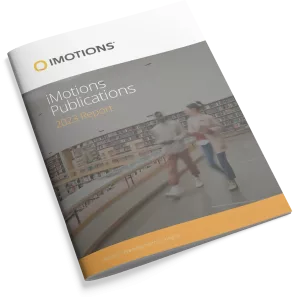-
Game Atmosphere: Effects of Audiovisual Thematic Cohesion on Player Experience and Psychophysiology
The game atmosphere and game audio are critical factors linked to the commercial success of video games. However, game atmosphere has been neither operationalized nor clearly defined in games user research literature, making it difficult to study. We define game atmosphere as the emerging subjective experience of a player caused by the strong audiovisual thematic […]
-
A team leader’s gaze before and after making requests in emergency care simulation: a case study with eye-tracking glasses
The advanced technology of eye-tracking enables us to analyse healthcare professionals’ (HCPs) gaze behaviours. Gaze analysis has great potential to capture HCPs’ non-technical skills, especially situational awareness (SA).1 The SA framework has three levels. Level 1 involves perceiving an event, level 2 understanding what is being perceived importantly and level 3 being able to make predictions. How to […]
-
Measuring Arousal and Emotion in Healthcare Employees Using Novel Devices
A positive working environment is fundamental for reducing employee turnover, and increasing engagement and productivity. Technologies such as wearable sensors and video analysis of facial expressions can be used to objectively measure the emotional responses of employees in real-time in the workplace. The study aims were to perform a preliminary investigation into the validities of […]
-
Desired Content versus Digital Advertisements: An Eye-Tracking User Experience Study
Advertisement repetition is known to enhance recall and awareness towards a certain stimulus. However, overexposure is also recognized to negatively impact user experience (UX). Little is understood on how many repetitions are required to achieve a tolerable balance between user experience and advertising. Likewise, the number of displayed advertisements versus seen advertisements is also unclear. […]
-
MTGAT: Multimodal Temporal Graph Attention Networks for Unaligned Human Multimodal Language Sequences
Human communication is multimodal in nature; it is through multiple modalities, i.e., language, voice, and facial expressions, that opinions and emotions are expressed. Data in this domain exhibits complex multi-relational and temporal interactions. Learning from this data is a fundamentally challenging research problem. In this paper, we propose Multimodal Temporal Graph Attention Networks (MTGAT). MTGAT […]
-
Social attention to activities in children and adults with autism spectrum disorder: effects of context and age
Diminished visual monitoring of faces and activities of others is an early feature of autism spectrum disorder (ASD). It is uncertain whether deficits in activity monitoring, identified using a homogeneous set of stimuli, persist throughout the lifespan in ASD, and thus, whether they could serve as a biological indicator (“biomarker”) of ASD. We investigated differences […]
-
Muscle Movements for Non-Invasive Thermal Discomfort Detection via Bio-Sensing Technology
In the time of climate change, as heat waves become a more regular occurrence, indoor thermal comfort is an important factor in day to day life. Due to such circumstances, many researchers have focused their studies on finding an effective solution that will not only enable thermal comfort, but also increase satisfaction within the indoor […]
-
The Study of Facial Muscle Movements for Non-Invasive Thermal Discomfort Detection via Bio-Sensing Technology. Part I: Development of the Experimental Design and Description of the Collected Data
In the time of climate change, as heat waves become a more regular occurrence, indoor thermal comfort is an important factor in day to day life. Due to such circumstances, many researchers have focused their studies on finding an effective solution that will not only enable thermal comfort, but also increase satisfaction within the indoor […]
-
How online advertising competes with user-generated content in TripAdvisor. A neuroscientific approach
Drawing on cognitive load theory, congruence research, and dual processing models, the purpose of this study is to determine the effectiveness of online advertising in social media. To this end, three separate studies were conducted. First, using eye-tracking and electroencephalography, we examine the differences, based on whether or not an ad is embedded, in subjects’ […]
-
Exploring the Relationship between Speech and Skin Conductance for Real-Time Arousal Monitoring
Monitoring human emotions through wearable systems has become an important area of research. Electrodermal activity (EDA) has proven to be a good indicator of emotional arousal, and numerous works have focused on using EDA data to predict emotional states. However, to successfully integrate EDA data into real-time wearable emotion recognition systems, several challenges of practical […]
Research Report 2023
In-depth look at the scientific landscape as powered by iMotions software, showcasing groundbreaking research and the impact of our tools in various scientific and industrial fields.

Share Your Research

850+ universities worldwide with an iMotions human behavior lab
73 of the top 100 highest ranked universities
710+ published research papers using iMotions
iMotions is used for some of the most interesting human behavior research studies carried out by top researchers around the world. Contact us to have your publication featured here.
The authors of these publications have used iMotions as a software tool within their research.
“Software should be cited on the same basis as any other research product such as a paper or a book; that is, authors should cite the appropriate set of software products just as they cite the appropriate set of papers” (Katz et al., 2020).
We therefore encourage you to cite the use of iMotions where appropriate.
How to cite iMotions
APA
iMotions (10), iMotions A/S, Copenhagen, Denmark, (2024).
Note: adjust the version and year where relevant.
5 Most Popular Blogs
Learn How to Conduct Human Behavior Research with iMotions
Publications
Read publications made possible with iMotions
Blog
Get inspired and learn more from our expert content writers
Newsletter
A monthly close up of latest product and research news





